
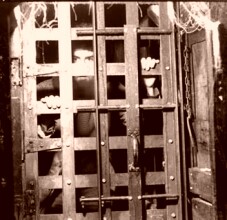
People have been subjected to torture in one form or another for thousands of years. During the period from 1000 AD to 2000 AD, Europe and the Middle East saw the invention of numerous methods of torture. Some forms were simple, like the use of fire or physical abuse; others required complicated devices.
Torture was commonly used not to extract information, but as a means of revenge and punishment, or as a way to force the prisoner to 'confess' before being put to death. All forms of torture were brutal, as you will see.
|
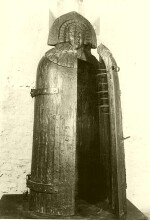
|
The SARCOPHAGUS
The sarcophagus was a coffin-like container into which the prisoner was placed. It was fitted with spikes on the inside that pierced different parts of the body ... but never damaged vital organs. This ensured that the victim remained alive, hanging upright.
The device could be opened both from the front and the back without the victim being able to get out. Each time the sarcophagus doors were opened and closed, the spikes penetrated the same wounds as before, inflicting terrible agony. The container was so thick that if the doors were closed, no sound could be heard from outside.
|
BOILING
Boiling a prisoner in hot water, oil, or other liquid was one of the most common methods of torture, probably because it didn't require any special tools, and because it could be applied gradually, allowing the prisoner to remain alive and in pain for a long time.
The hot liquid in the pot was also used to discourage attackers from climbing the walls of the castle, by pouring it onto them.
|
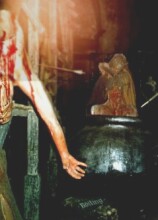
|
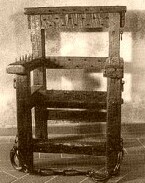
|
THE HEATED CHAIR
The chair was made from iron, and sometimes had short spikes on the arms and seat. The prisoner was chained to the chair, and a fire was built underneath. Recent evidence suggests that this method of torture may still be practiced in some countries today.
|
THE RACK
The rack was a device used to stretch prisoners. It usually involved some sort of wheel and axle around which ropes were wound. The victim would lie flat, or stand anchored to the floor, and when the wheel was turned, he would be pulled, causing excruciating pain. Often he would be left like that for days. The rack was a widely used torture device.
|
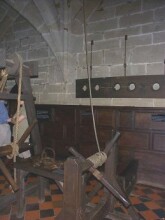
|
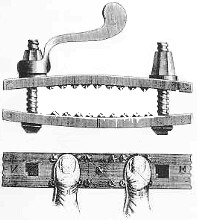
|
THE THUMB SCREW
This nasty little device was small and portable, and did not cause death; its sole purpose was to apply pain. The prisoner's thumbs were imapaled on a small spiked board, and then covered with a top plate, also containing small spikes, that could be tightened with screws.
Damage to the fingers has always been a common torture method; even today in some countries, prisoners' fingernails are forcefully removed to inflict pain.
|
THE WHEEL
This device was similar to the rack, above, but the prisoner was tied to the circumference of a wheel. Various other tortures could be applied while the victim was immobilized, the most common of which was rotating him through a fire built below the wheel.
Apparently this type of torture was used frequently by religious persecutors in the Middle Ages.
|
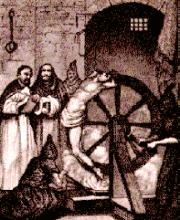
|
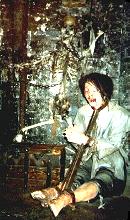
|
CAPTIVITY
Whatever forms of torture the captive was subjected to, his future was not bright. Prisoners who survived torture were usually left to die in the pit, often manacled or chained to a wall. Escape was impossible.
Regrettably, such treatment of human beings is not just a historical curiosity. As mentioned previously, there remain many countries in the world today where criminals, political prisoners, or even ethnic minorities are persecuted, imprisoned, tortured, and killed, using methods similar to or identical with those described above.
|
Back
|

